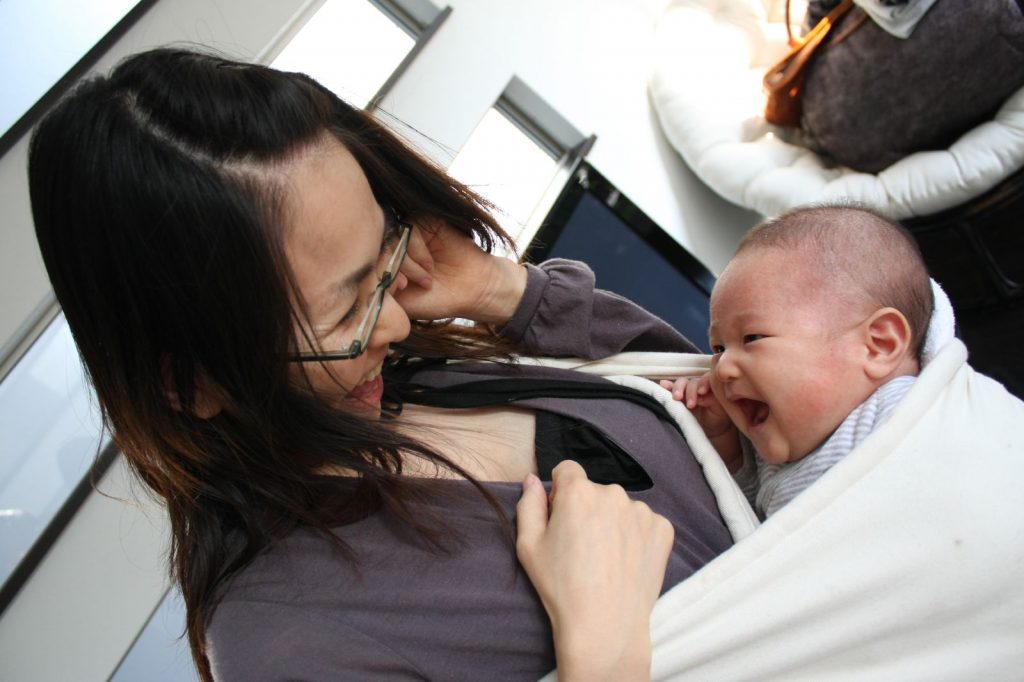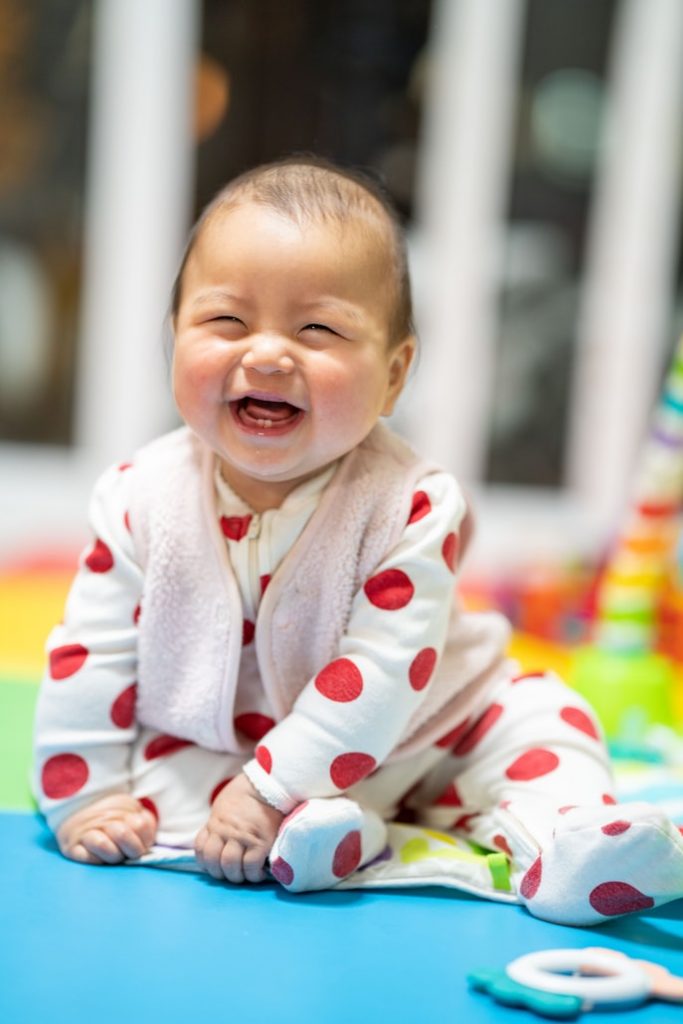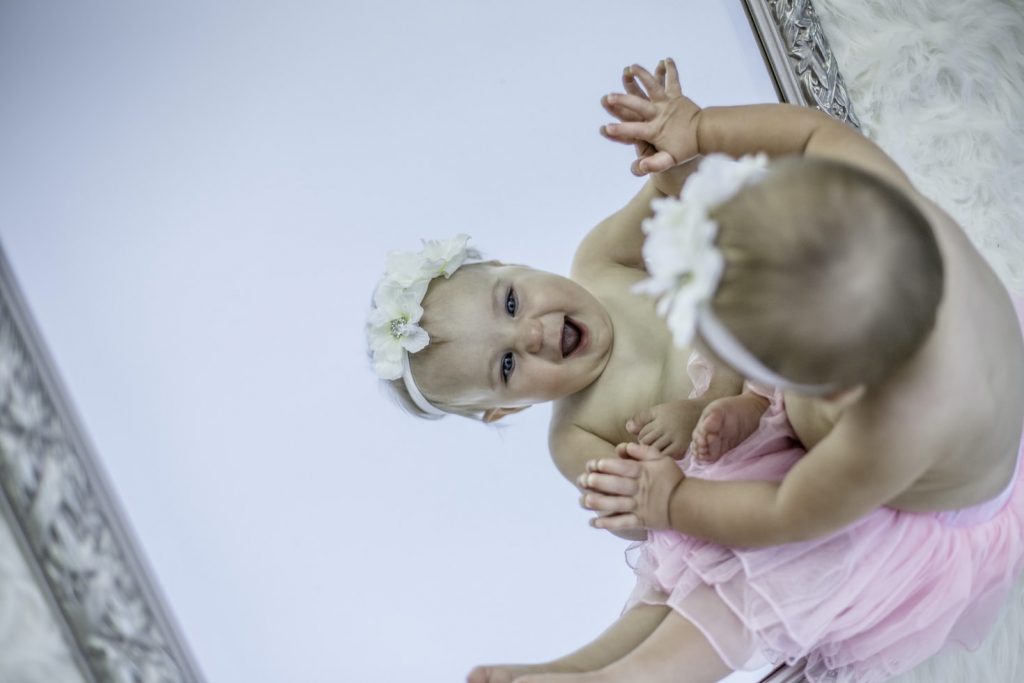Learning Objectives
- Identify styles of temperament and explore goodness of fit
- Understand the early theories of attachment
- Contrast styles of attachment according to the Strange Situation Technique
- Explain the factors that influence attachment
- Describe self-awareness, stranger wariness, and separation anxiety
- Use Erikson’s theory to characterize psychosocial development during infancy
Temperament
Perhaps you have spent time with a number of infants. How were they alike? How did they differ? How do you compare with your siblings or other children you have known well? You may have noticed that some seemed to be in a better mood than others and that some were more sensitive to noise or more easily distracted than others. These differences may be attributed to temperament. Temperament is the innate characteristics of the infant, including mood, activity level, and emotional reactivity, noticeable soon after birth.
In a 1956 landmark study, Chess and Thomas (1996) evaluated 141 children’s temperament based on parental interviews. Referred to as the New York Longitudinal Study, infants were assessed on nine dimensions of temperament including: activity level, rhythmicity (regularity of biological functions), approach/withdrawal (how children deal with new things), adaptability to situations, intensity of reactions, threshold of responsiveness (how intense a stimulus has to be for the child to react), quality of mood, distractibility, attention span, and persistence. Based on the infants’ behavioural profiles, they were categorized into three general types of temperament:
- Easy child (40 percent), who is able to quickly adapt to routine and new situations, remains calm, is easy to soothe, and usually is in a positive mood.
- Difficult child (10 percent), who reacts negatively to new situations, has trouble adapting to routine, is usually in a negative mood, and cries frequently.
- Slow-to-warm-up child (15 percent), who has a low activity level, adjusts slowly to new situations, and is often in a negative mood.
As can be seen, the percentages do not equal 100 percent as some children were not able to be placed neatly into one of the categories. Think about how you might approach each type of child in order to improve your interactions with them. An easy child will not need much extra attention, while a slow-to-warm-up child may need to be given advance warning if new people or situations are going to be introduced. A difficult child may need to be given extra time to burn off their energy. A caregiver’s ability to work well and accurately read the child will enjoy a goodness of fit, meaning their styles match and communication and interaction can flow. Parents who recognize each child’s temperament and accept it will nurture more effective interactions with the child and encourage more adaptive functioning. For example, an adventurous child whose parents regularly take her outside on hikes would provide a good “fit” to her temperament.
Parenting is bidirectional: Not only do parents affect their children, children influence their parents. Child characteristics, such as temperament, affect parenting behaviours and roles. For example, an infant with an easy temperament may enable parents to feel more effective, as they are easily able to soothe the child and elicit smiling and cooing. On the other hand, a cranky or fussy infant elicits fewer positive reactions from his or her parents and may result in parents feeling less effective in the parenting role (Eisenberg et al., 2008). Over time, parents of more difficult children may become more punitive and less patient with their children (Clark, Kochanska, and Ready, 2000; Eisenberg et al., 1999; Kiff, Lengua, and Zalewski, 2011). Parents who have a fussy, difficult child are less satisfied with their marriages and have greater challenges in balancing work and family roles (Hyde, Else-Quest, and Goldsmith, 2004). Thus, child temperament is one of the characteristics that influences how parents behave with their children.
Temperament does not change dramatically as we grow up, but we may learn how to work around and manage our temperamental qualities. Temperament may be one of the things about us that stays the same throughout development. In contrast, personality, defined as an individual’s consistent pattern of feeling, thinking, and behaving, is the result of the continuous interplay between biological disposition and experience.

Personality also develops from temperament in other ways (Thompson, Winer, and Goodvin, 2010). As children mature biologically, temperamental characteristics emerge and change over time. A newborn is not capable of much self-control, but as brain-based capacities for self-control advance, temperamental changes in self-regulation become more apparent. For example, a newborn who cries frequently doesn’t necessarily have a grumpy personality; over time, with sufficient parental support and increased sense of security, the child might be less likely to cry.
In addition, personality is made up of many other features besides temperament. Children’s developing self-concept, their motivations to achieve or to socialize, their values and goals, their coping styles, their sense of responsibility and conscientiousness, and many other qualities are encompassed into personality. These qualities are influenced by biological dispositions, but even more by the child’s experiences with others, particularly in close relationships, that guide the growth of individual characteristics. Indeed, personality development begins with the biological foundations of temperament but becomes increasingly elaborated, extended, and refined over time. The newborn that parents gazed upon thus becomes an adult with a personality of depth and nuance.
Infant Emotions
At birth, infants exhibit two emotional responses: attraction and withdrawal. They show attraction to pleasant situations that bring comfort, stimulation, and pleasure, and they withdraw from unpleasant stimulation such as bitter flavours or physical discomfort. Around two months infants exhibit social engagement in the form of social smiling as they respond with smiles to those who engage their positive attention (Lavelli and Fogel, 2005).
Social smiling becomes more stable and organized as infants learn to use their smiles to engage their parents in interactions. Pleasure is expressed as laughter at three to five months, and displeasure becomes more specific as fear, sadness, or anger between ages six and eight months. Anger is often the reaction to being prevented from obtaining a goal, such as a toy being removed (Braungart-Rieker, Hill-Soderlund, and Karrass, 2010). In contrast, sadness is typically the response when infants are deprived of a caregiver (Papousek, 2007). Fear is often associated with the presence of a stranger, known as stranger wariness, or the departure of significant others, known as separation anxiety. Both appear sometime between six and fifteen months, after object permanence has been acquired. Further, there is some indication that infants may experience jealousy at as young as six months (Hart and Carrington, 2002).
Emotions are often divided into two general categories: basic emotions, such as interest, happiness, anger, fear, surprise, sadness, and disgust, which appear first; and self-conscious emotions, such as envy, pride, shame, guilt, doubt, and embarrassment. Unlike primary emotions, secondary emotions appear as children start to develop a self-concept, and require social instruction on when to feel such emotions. The situations in which children learn self-conscious emotions varies from culture to culture. Individualistic cultures teach us to feel pride in personal accomplishments, while in more collectivist cultures children are taught to not call attention to themselves unless they wish to feel embarrassed for doing so (Akimoto and Sanbinmatsu, 1999).
Facial expressions of emotion are important regulators of social interaction. In the developmental literature, this concept has been investigated under the process of social referencing, whereby infants seek out information from others to clarify a situation and then use that information to act (Klinnert, Campos, and Sorce, 1983). To date, the strongest demonstration of social referencing comes from work on the visual cliff. In the first study to investigate this concept, Campos and colleagues (Sorce, Emde, Campos, and Klinnert, 1985) placed mothers on the far end of the “cliff” (a table) from the infant. Mothers first smiled to the infants and placed a toy on top of the safety glass to attract them; infants invariably began crawling to their mothers. When the infants were in the centre of the table, however, the mother then posed an expression of fear, sadness, anger, interest, or joy. The results were clearly different for the different faces: no infant crossed the table when the mother showed fear; only 6 percent did when the mother posed anger; 33 percent crossed when the mother posed sadness; and approximately 75 percent crossed when the mother posed joy or interest.

Other studies provide similar support for facial expressions as regulators of social interaction. Experimenters posed facial expressions of anger, disgust, or neutral positioning toward babies as they moved toward an object and measured the amount of inhibition the babies showed in touching the object (Bradshaw, 1986). The results for 10- and 15-month-olds were the same: anger produced the greatest inhibition, followed by disgust, with neutral the least. This study was later replicated using joy and disgust expressions, altering the method so that the infants were not allowed to touch the toy (compared with a distractor object) until one hour after exposure to the expression (Hertenstein and Campos, 2004). At fourteen months, significantly more infants touched the toy when they saw joyful expressions, but fewer touched the toy when they saw disgust.
A final emotional change is in self-regulation. Emotional self-regulation refers to strategies we use to control our emotional states so that we can attain goals (Thompson and Goodvin, 2007). This requires effortful control of emotions and initially requires assistance from caregivers (Rothbart, Posner, and Kieras, 2006). Young infants have very limited capacity to adjust their emotional states and depend on their caregivers to help soothe themselves. Caregivers can offer distractions to redirect the infant’s attention and comfort to reduce the emotional distress. As areas of the infant’s prefrontal cortex continue to develop, infants can tolerate more stimulation. By four to six months, babies can begin to shift their attention away from upsetting stimuli (Rothbart et al., 2006). Older infants and toddlers can more effectively communicate their need for help and can crawl or walk toward or away from various situations (Cole, Armstrong, and Pemberton, 2010). This aids in their ability to self-regulate. Temperament also plays a role in children’s ability to control their emotional states, and individual differences have been noted in the emotional self-regulation of infants and toddlers (Rothbart and Bates, 2006).

Development of sense of self: During the second year of life, children begin to recognize themselves as they gain a sense of self as object. In a classic experiment by Lewis and Brooks (1978) children aged nine to twenty-four months were placed in front of a mirror after a spot of rouge was placed on their nose as their mothers pretended to wipe something off the child’s face. If the child reacted by touching his or her own nose rather that of the “baby” in the mirror, it was taken to suggest that the child recognized the reflection as themself. Lewis and Brooks found that somewhere between fifteen and twenty-four months most infants developed a sense of self-awareness. Self-awareness is the realization that you are separate from others (Kopp, 2011). Once a child has achieved self-awareness, the child is moving toward understanding social emotions such as guilt, shame, or embarrassment, as well as sympathy or empathy.

